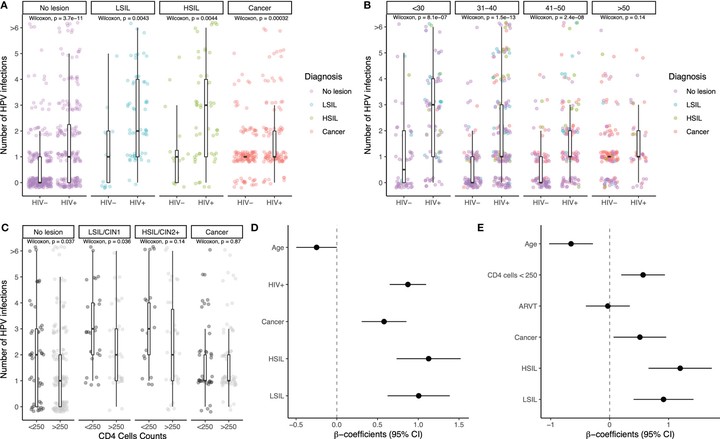HPV Type Distribution in HIV Positive and Negative Women With or Without Cervical Dysplasia or Cancer in East Africa

Background: Women living with HIV in sub-Saharan Africa are at increased risk to develop cervical cancer (CC), which is caused by persistent infection with 13 oncogenic human papilloma viruses (HR-HPVs). It is important to accurately identify and target HIV-positive women at highest risk to develop CC for early therapeutic intervention.
Methods: A total of 2,134 HIV+ and HIV− women from South-West Tanzania were prospectively screened for cervical cancer and precancerous lesions. Women with cervical cancer (n=236), high- and low-grade squamous intraepithelial lesions (HSIL: n=68, LSIL: n=74), and without lesion (n=426) underwent high-resolution HPV genotyping.
Results: Eighty percent of women who were diagnosed with HSIL or LSIL were living with HIV. Any lesion, young age, HIV status, and depleted CD4 T cell counts were independent risk factors for HPV infections, which were predominantly caused by HR-HPV types. While multiple HR-HPV type infections were predominant in HIV+ women with HSIL, single-type infections predominated in HIV+ CC cases (p=0.0006). HPV16, 18, and 45 accounted for 85% (68/80) and 75% (82/110) of HIV+ and HIV− CC cases, respectively. Of note, HPV35, the most frequent HPV type in HSIL-positive women living with HIV, was rarely detected as a single-type infection in HSIL and cancer cases.
Conclusion: HPV16, 18, and 45 should receive special attention for molecular diagnostic algorithms during CC prevention programs for HIV+ women from sub-Saharan Africa. HPV35 may have a high potential to induce HSIL in women living with HIV, but less potential to cause cervical cancer in single-type infections.